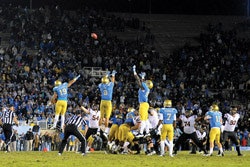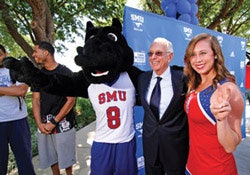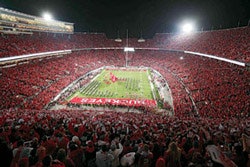A season potentially worth millions of dollars turned on a dime. Arizona State University's football team had just scored a touchdown to take a five-point lead on UCLA, then recovered a fumble on the ensuing kickoff.

A season potentially worth millions of dollars turned on a dime. Arizona State University's football team had just scored a touchdown to take a five-point lead on UCLA, then recovered a fumble on the ensuing kickoff. With 7:48 remaining on the fourth-quarter clock and the ball on the Bruins' 27-yard line, 19th-ranked ASU appeared poised to win its seventh game of the season against only two losses. Instead, the Sun Devils missed a field goal attempt, surrendered a last-minute UCLA touchdown and missed another field goal try as time expired. They would not win another game in 2011.
Perhaps no one - save head coach Dennis Erickson, who would be fired at season's end - lost more sleep over the UCLA loss than Stephen Ponder, Arizona State's senior associate athletics director for development. Ponder estimates that game cost his department as much as $250,000 in future gifts, and he puts the cumulative impact of the football team's late-season collapse well into seven figures. That's how much his staff's fortunes hinge on those of the Sun Devils. "It's usually like a roller coaster," Ponder says.
But as rapidly as the football team's 2011 fortunes plummeted, it's been a sustained uphill climb for ASU athletics fundraisers since the housing collapse hit Phoenix (and by extension Arizona State's home of Tempe 10 miles away) as hard as any metropolitan area in the United States four years ago. In 2008, the Sun Devil Club (which a year earlier had replaced the Sun Angel Foundation, chartered in 1947) counted 12,500 active donors as members. Two years later, Sun Devil Club membership stood at a mere 4,000. The annual fund had dropped from $8.5 million to $5 million. The problem, according to Ponder, whose own home is worth exactly half of what he paid for it upon arriving at Arizona State in 2006, is that ASU fundraising has relied too heavily for too long on football ticket sales.
"The Sun Angel Foundation model was based on the concept that if you buy football tickets, you pay a premium to sit in better seats. That model exists everywhere. But here, that's what the Sun Angel Foundation was known as," says Ponder, the current National Association of Athletic Development Directors president. "In culture and mentality, people were like, 'Yeah, I used to give. I bought football tickets, and then I stopped buying tickets.' So they stopped giving. What we've been working on since 2007, the year after I got here, is trying to flip this model. We still want people to buy football tickets and make a gift associated with their football tickets, but we really want people, whether they live in Chandler or Tempe or Phoenix or Chicago, to make a gift - $10 a month, $100 a year. Get involved with supporting a program and then hopefully we can build the base of the pyramid wide enough so we can start talking to them about bigger-picture issues."
Talk about big issues. Nothing is more integral to the forward progress of an athletic department these days than the consistent flow of cash - specifically, private dollars. A weak economy only serves to emphasize fundraising's importance. "Development is one of an athletic department's most needed areas," says Kay Hargrave, senior associate athletics director for development at Auburn University and third vice president of NAADD, which boasts a membership approaching 1,000 for the first time in its 20-year history. "Athletic departments have not been raising money for that long, and people are finally figuring out that you can't have a $150 football ticket. You can't have a $75 basketball ticket. The only area where you have any upside - and you really don't know what it is, because so much is dictated by the economy and your fans' emotions - is private support."
Like any successful fundraiser, Hargrave, an Auburn alum who joined the athletic department's development team at age 25 and worked on its first-ever capital campaign, is constantly expanding her prospect list, targeting everyone from young alumni to professional athletes. Within the past four years, Auburn has developed three recognition societies for donors at the $100,000, $250,000 and $500,000 levels, and Hargrave reports that six-figure gifts are coming in at a pace equal to lower-level donations. That is not to say that it has been easy. "Even though it is more difficult securing gifts in this economy, it's not because people aren't willing. We don't hear 'no'; we just hear 'not right now,' " she says. "And the advice I always give is, 'Don't ever stop asking,' because the economy is going to turn around, and when it does, if you have not kept in contact with your people, then it's going to be really hard to get back on their radar."
It's all part of a moves management process that shepherds a prospect through five phases: initial contact, cultivation, solicitation, solicitation follow-up and stewardship once a gift is secured. The quality time with donors afforded by stewardship calls is particularly critical during an economic downturn, according to Hargrave. "Stewardship could be a personal visit to thank somebody for what they've done," she says. "And if you're doing a stewardship call the right way, you're still talking about your current needs."
For the past several years, moves management and related concepts have been part of a one-day curriculum called "Fundamentals of Athletics Development" (or FOAD), staged immediately ahead of the annual NAADD conference in June. Says Hargrave, "Moves management is the same whether you're at a high school or a junior college or a BCS school. The way that you make an ask is going to be the same whether you're asking for $5,000 at a community college or half a million at a university. People give money to people, and people give money to people they trust in organizations that have missions they believe in."
Designed as a sort of Fundraising 101 crash course, FOAD has begun drawing a number of high-ranking athletics administrators, including athletic directors. Athletics development is a new enough industry that some ADs may not have much personal background in it, and to them a travel-heavy development budget may look fatter than those of, say, the marketing or compliance departments, and thus a prime target for belt-tightening. "That isn't a good business model, because if you're cutting the area that can provide you revenue, you've taken away the only option you have at any sort of growth. We should be building our staffs even more," says Hargrave, adding that her staff grew by two full-timers this year to a total of six, each on the road at least three or four days per week. "There is accountability in development. There's a scoreboard at the end of every day, at the end of every quarter and at the end of every year."

The scoreboard at Southern Methodist University, home to the only football program in history to receive the NCAA's death penalty, has been lighting up of late, with Mustang fundraisers having much to sell: three consecutive bowl appearances (and two bowl victories) under June Jones, the hiring this spring of Hall of Fame basketball coach Larry Brown, the ongoing $42 million renovation of its basketball arena, a pending transition to the Big East Conference. And there's plenty of donor buy-in. Last year, SMU athletics raised a record $6.6 million in total annual giving, including $2.3 million in unrestricted gifts to the Mustang Club (funds distributed at the athletic director's discretion) and another $4.3 million in restricted funds (designated by the donor for specific sports). At the May 31 close of FY '12, Mustang Club donations topped $2.5 million and total gifts to the annual fund exceeded $7.8 million - both record amounts.
"Our donors understand the price of poker is going up," says SMU senior associate athletics director for development and external affairs Tim McMurray, who served as NAADD president in 2009-10 while at Northern Illinois. "Thankfully, we've got a donor base that lends itself to being able to play at the big kids' table."
That said, contacting and cultivating prospects at SMU is a cooperative effort, according to McMurray, who was hired two years ago with input from both the university's development and athletics departments, making SMU his latest stop on a long fundraising resume. "At NIU, Lamar and Texas State, we in athletics were competing against the alumni office for annual gift support," he says. "Here, it's different, and I brag about this all the time. SMU Alumni Giving and Relations promotes giving to the university. They don't care where it goes."
One of five university development officers spread throughout the country recently found in Washington, D.C., an SMU alum and her husband who were interested in making a leadership gift to athletics, just as they had done for the husband's Houston-based alma mater, Rice. "They're what I call travel agents," McMurray says of the national giving team members. "They don't care where you choose to vacation. They just make sure you vacation and book it with us."
Moreover, prior to McMurray's arrival, SMU athletics had no dedicated nationwide fundraising campaign of its own, despite the fact that nearly 80 percent of donations to the Mustang Club were coming from only 40 percent of SMU's alums - those still residing in Dallas. Make no mistake, big oil and real-estate money has buoyed the athletic department nicely; two dozen donors have committed $100,000 a year for five years as part of a Football Circle of Champions, established upon Jones' arrival as head coach in 2008. Still, there was a lot of untapped potential elsewhere.
So, in the fall of 2010, McMurray assembled 31 volunteers in 21 regions of the country to actively solicit on behalf of the Mustang Club. "They've hosted events. They've sent e-mails on our behalf," says McMurray, adding that the wider cast netted $181,000 in new and increased donations during the national campaign's first eight months, accounting for more than half of the Mustang Club's overall giving increase between FY '10 and FY '11. "I obviously can't fly around the country to every city or I'd blow the budget. But when we play football in a region, I'll go in a day early and I'll visit with those volunteers, see what we can do differently. That national campaign has made a difference in just educating people on our needs."
The national buzz hit its peak in mid-April with the hiring of Brown, a move that "opens doors that we probably weren't going to even get to knock on," says McMurray. Before month's end, SMU had taken 200 new basketball season-ticket orders - the same number registered all of last off-season - and the school's first-ever donor seating program for basketball is in the works. Then, on May 17, longtime SMU president Gerald Turner fired Steve Orsini, the athletic director responsible for hiring both Jones and Brown, for reasons that weren't immediately clear. McMurray worked the phones late into the night in an effort to keep unnerved donors' doors from closing. "Just calming people down and assuring them that it's okay," says McMurray, who has dealt with AD transitions at every school he's worked for. "There's momentum here, and we've come too far and invested too much financially and in personnel and effort. I know our university leadership is committed to not taking a step back. Sometimes AD transition is for the right reasons, and sometimes it's not, but we have to embrace it at SMU as an opportunity to move forward. We have to move forward."

Some might assume that a sort of fundraising inertia exists at certain schools, that identifying prospects - in good times and bad - is as easy as opening the daily mail. At Ohio State University, for instance, there are waiting lists for every category of seating at 102,329-seat Ohio Stadium, with an entry-level donation requirement of $1,500 for the right to buy tickets. But there are also 36 sports (most among BCS schools) and a $126 million budget (second behind Texas) to support. And Ohio State showed four years ago that no school's athletics development operation is recession-proof. In 2007, Buckeye fundraisers brought in a record $44 million. For FY '08, the number fell to $33.4 million, "our most significant drop we've probably ever had," according to Pat Chun, OSU's executive associate athletics director for external relations.
"We all had to sit in a room and figure out, 'Alright, people aren't going to give,' " Chun says. "We had one of our lowest years ever, but we still had to get out and get in front of people, because you know the economy is going to flip. It might not be in a month, a year or two years, but we had to stay in front of people and let them understand that, hey, we're still focused on and in alignment with our core mission and values, and whenever the economy turns, we're still here. Long after I'm gone from this place, there are going to be people, families, corporations that are going to continue to give consistently to help us achieve our goals and our mission."
Ohio State is the rare institution that rewards donors with athletics perks, including the right to purchase season tickets, for gifts made to the university at large. "The university philosophy has always been that a gift is a gift, no matter where on campus you give it. So if I give $2,500 to the College of Law, that should be no different than giving $2,500 to athletics, and that should afford me the opportunity to purchase season tickets," Chun says. "It's just the way the culture is at Ohio State, so we embrace it. There are a lot of big-picture advantages to it, because it creates a lot of collegiality across campus - people working together. Our job as a development staff is to try to find the appropriate fundraising opportunity for the donor. That's why it's called development, because then it gives us the opportunity to engage the donor, and hopefully it creates consistent giving throughout a lifetime, rather than just a one-time transactional give-to-get."
The supply-and-demand stability of an Ohio State is something Arizona State's Ponder can only dream about. As reigning Pac-10 (now Pac-12) Conference co-champions, Arizona State sold more football season tickets in 2008 than it had in a quarter-century. But that total of 50,000, which included students, still fell well short of Sun Devil Stadium's 72,000 capacity. And those fans saw only three home victories that fall. Then, following six straight losses to close out 2009, season-ticket sales sagged to 29,000 by 2010. "So, 21,000 gone," says Ponder, whose department must also compete with four professional sports franchises, including the NFL's air-conditioned Cardinals, for fans' discretionary dollars. "Everything is predicated on football being a winner. Every time we lose a ball game, it's a hit to the single-game base. You spend a lot of effort trying to fill a game, and then you have to do it again the next week. That's kind of the way we're living right now."
After back-to-back $38.5 million annual-fund drives, Ohio State, despite an unenviable year from a PR perspective, again topped the $40 million mark in 2011 - a sign, perhaps, that the economy there is on the upswing.
Ponder is seeing it, too, in his corner of the fundraising universe. "The economy is getting better here. People are feeling better. We had a coaching change in football, and right or wrong, any time there's a change, people are attracted to it," he says, already hopeful that September will bring a few base-building victories. "I think they'll come back for single games this year, and then we'll have a really good chance next year to have a breakout year. The fans that we do have are fantastic. They stick with us and they're phenomenal. We just haven't traditionally been able, over the past 30 years, to sustain the donor culture to afford the success that we want. That's ultimately what we're after."

































